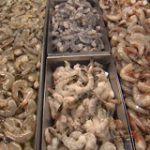Six countries in need of greater improved environmental stewardship practices, report finds
 Six of the world’s leading shrimp producers are in need of aquaculture improvement projects and zone-management strategies that address “pressing” sustainability concerns, a leading seafood NGO has determined.
Six of the world’s leading shrimp producers are in need of aquaculture improvement projects and zone-management strategies that address “pressing” sustainability concerns, a leading seafood NGO has determined.
In its first report on Southeast Asia’s shrimp sector, Sustainable Fisheries Partnership on April 13 detailed potential Aquaculture Improvement Project (AIP) engagement opportunities for supply chain partners sourcing from Thailand, China, Indonesia, Vietnam, India and Bangladesh.
“There is no doubting the value of shrimp farming to the economies of these countries, but something revolutionary needs to be done to tackle the ever-repeating cycle of disease outbreaks,” said Anton Immink, SFP’s Director of Aquaculture and a member of the Advocate’s Editorial Advisory Board.
“Just as salmon has done, the shrimp industry needs to recognize that farms don’t operate in isolation. Strong industry leadership is needed at the local, national and regional level if shrimp is going to live up to its full potential.”
Neighboring farms operating in given regions in these countries, or zones, are susceptible to disease threats via shared water resources, which SFP said necessitates management practices in which producers should collaborate and share data to prevent outbreaks. SFP identified 16 provinces — eight in Thailand alone — with significant production where AIPs are needed. According to SFP, these 16 provinces account for approximately 35 percent of global warm-water shrimp exports.
Something revolutionary needs to be done to tackle the ever-repeating cycle of disease outbreaks.
Certification programs like Best Aquaculture Practices, the Aquaculture Stewardship Council and GlobalGAP address improvements at the farm level, SFP noted, but not on a zonal scale.
Farmed shrimp production in Southeast Asia has witnessed “rapid and generally uncoordinated growth” with continued intensification, said SFP analyst Nicole Portley, who authored the report. This has led to major disease outbreaks such as Early Mortality Syndrome (EMS), ongoing impacts to sensitive habitats and water quality concerns. Due to widespread impacts of EMS in Thailand, Vietnam, China and India have all surpassed it to become the world’s leading shrimp exporters, the report stated.
While Thailand is expected to continue to recover from EMS, the spore-forming parasite Enterocytozoon hepatopenaei (EHP), which slows shrimp growth and weakens productivity, is increasing in prevalence.
SFP analyzed 10 countries in Southeast Asia in its report — also including Malaysia, Myanmar, Cambodia and the Philippines, which keep the majority of their Pacific white shrimp production for domestic consumption. China, by far the world’s leading shrimp producer with volumes in 2013 reaching 3.56 million metric tons (live weight), keeps 88 percent of its shrimp production for domestic consumption, a strong indicator of the high demand for shrimp in the country.
Author
-

James Wright
Editorial Manager
Global Aquaculture Alliance
Portsmouth, NH, USA
Related Posts

Responsibility
Aquaculture certification steers to zone management
Zone management is an emerging field of interest among industry stakeholders. Experts say it will aid in controlling diseases and in determining carrying capacities. We take a closer look at the management tool’s potential.

Responsibility
Zone management: Can aquaculture producers collaborate?
At the GOAL 2015 pre-conference workshop in Vancouver, British Columbia, Canada, a panel of aquaculture management experts determined that producers sharing water resources must work together to prevent the spread of disease and to become more attractive to investors.

Innovation & Investment
Is Africa a ‘new Asia’ for aquaculture?
Now is the time for investment in efficiency improvements, better genetics, health management and more competition and innovation in the feed sector. Let's not perpetuate the myth that just a little more investment in some technical solutions will solve the problems in Africa.

Responsibility
Opinion: Aquaculture’s way forward is to embrace zonal management
The idea that fish farms’ health and safety are interconnected is not new. Even the best-run farms are not protected from diseases or pollution from another farm close by, so further measures are necessary, argues Anton Immink of Sustainable Fisheries Partnership.

